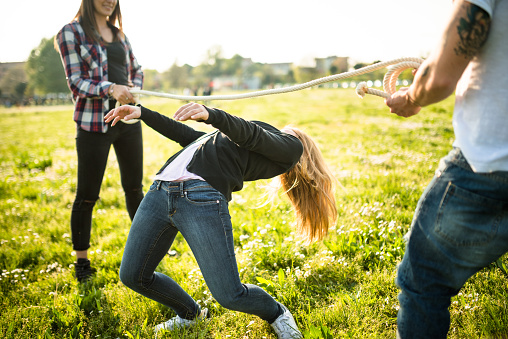Women's OutDoor Games
Skipping Rope
A skipping rope (British English) or jump rope (American English) is a tool used in the sport of skipping/jump rope where one or more participants jump over a rope swung so that it passes under their feet and over their heads. There are multiple subsets of skipping/jump rope, including single freestyle, single speed, pairs, three-person speed (Double Dutch), and three-person freestyle (Double Dutch freestyle) There are a few major organizations that support jump rope as a sport. Often separated by sex and age, events include hundreds of competitive teams all around the world. In the US, schools rarely have jump rope teams, and states do have sanction official events for elementary school. In freestyle events, jumpers use a variety of basic and advanced techniques in a routine of one minute, which is judged by a head judge, content judges, and performance judges. In speed events, a jumper alternates their feet with the rope going around the jumper every time one of their feet hits the ground for 30 seconds, one minute, or three minutes. The jumper is judged on the number of times the right foot touches the ground in those times.

Skipping Rope Tutorial
Limbo Game

Limbo is a popular game, based on traditions that originated on the island of Trinidad. The aim is to pass forwards under a low bar without falling or dislodging the bar. A horizontal bar, known as the limbo bar, is supported by two vertical bars. All contestants must attempt to go under the bar with their backs facing toward the floor. When passing under the bar, players must bend backwards. No part of their body is allowed to touch the bar, and no part other than their feet may touch the ground. They must not turn their head or neck to the side. Whoever knocks the bar off or falls is eliminated. After everyone has passed under the bar in this manner, the bar is lowered slightly and the contest continues. The contest ends when only one person can pass under the bar.
Limbo Game Tutorial
Hand Clap Games
The first hand-clap game most people have played is Pat-a-Cake with their parents. Songs and patterns get much more complicated from there. Usually there are two people involved, doing a series of clap patterns on their own and each other's hands while singing or chanting a rhythmic song. There are many rhymes listed online, but if you can learn from someone else or see it in a video, that is best, so that you can get the notes of the song and the rhythm of the clapping. From "Miss Mary Mack" to "Miss Susie" to "Say, Say, My Playmate," there are countless hand clap games to learn. Number of Players: Usually two, but creativity can allow for a third or fourth person. Equipment: None.

Hand Clap Tutorial
Chinese whispers Game

Chinese whispers (Commonwealth English) or telephone (American English). It is also called transmission chain experiments in the context of cultural evolution research, and is primarily used to identify the type of information that is more easily passed on from one person to another. Players form a line or circle, and the first player comes up with a message and whispers it to the ear of the second person in the line. The second player repeats the message to the third player, and so on. When the last player is reached, they announce the message they heard to the entire group. The first person then compares the original message with the final version. Although the objective is to pass around the message without it becoming garbled along the way, part of the enjoyment is that, regardless, this usually ends up happening. Errors typically accumulate in the retellings, so the statement announced by the last player differs significantly from that of the first player, usually with amusing or humorous effect. Reasons for changes include anxiousness or impatience, erroneous corrections, and the difficult-to-understand mechanism of whispering.